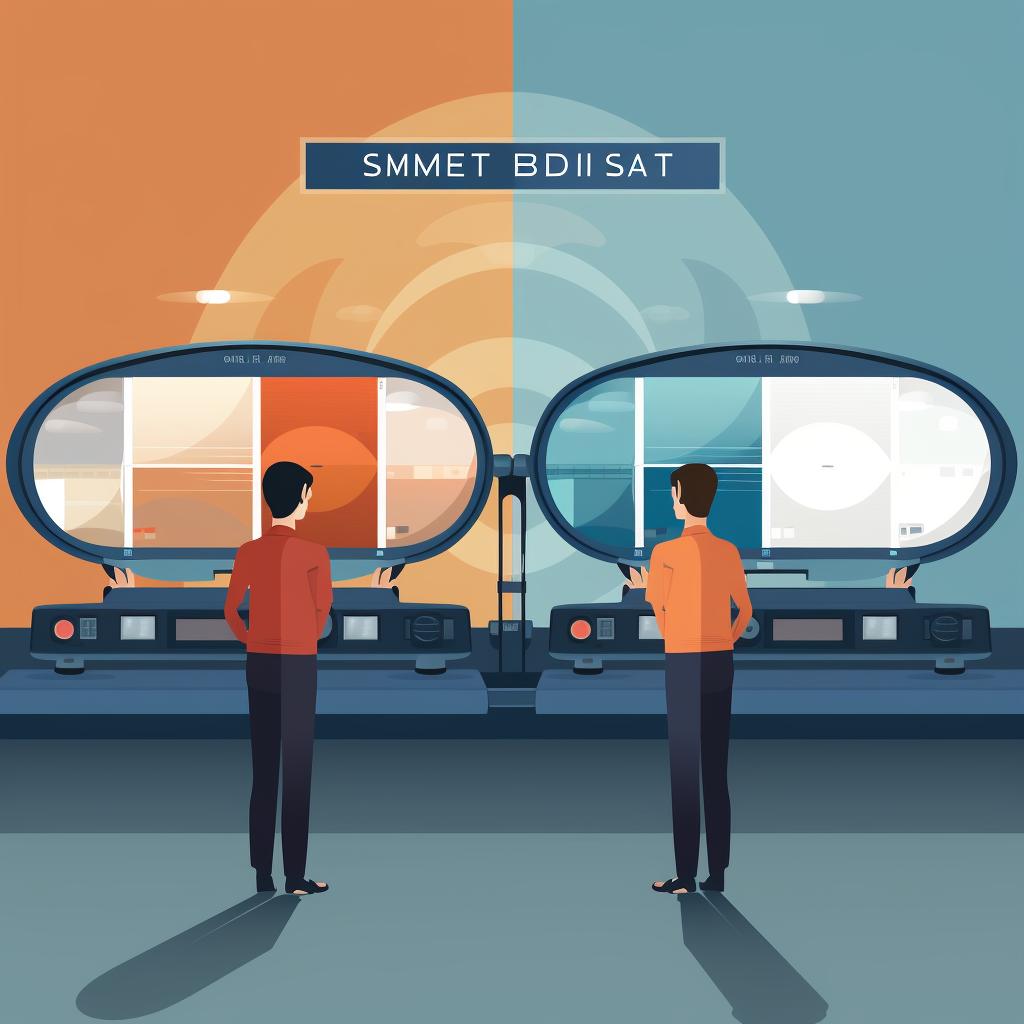Samantha Roadster is a passionate advocate for safe driving and a former professional race car driver. She has dedicated her post-racing career to educating new drivers on the importance of safety and proper driving techniques.
Blind spot monitors and rear cross traffic alert systems are crucial safety features that can greatly enhance your parking experience. These advanced technologies can help detect vehicles, pedestrians, and other obstacles that are often difficult to see during parking maneuvers. Let's delve into some suitable types of these systems and how they can improve your driving.
Let's Decode the Magic of Parking Assistance Tech 🚗💡
Parking assistance technology mainly includes blind spot monitors and rear cross traffic alerts. Blind spot monitors warn drivers of unseen vehicles in adjacent lanes, while rear cross traffic alerts notify drivers of crossing traffic when backing out of parking spaces.
Which Blind Spot Monitor is Your Perfect Parking Partner?
There are various types of blind spot monitors, each with their unique features and benefits. The best blind spot monitors are those that offer both visual and audio alerts, have a wide detection range, and can function well in different weather conditions.
Types of Blind Spot Monitors and Rear Cross Traffic Alert Systems
- Radar-based systems: These use radar sensors mounted on the car's rear to detect vehicles in the blind spot area.
- Camera-based systems: These utilize cameras fitted on the car's exterior to provide a visual image of the blind spot.
- Sonar-based systems: These use ultrasonic sensors to detect obstacles in the blind spot.
- Radar-based systems: These systems use radar sensors typically mounted on the rear bumper to detect approaching vehicles while reversing out of parking spaces.
- Camera-based systems: These use rear-mounted cameras to provide a visual display of the area behind the vehicle.
Types of Blind Spot Monitors and Rear Cross Traffic Alert Systems
- Radar-based systems: These use radar sensors mounted on the car's rear to detect vehicles in the blind spot area. Learn more about radar-based systems.
- Camera-based systems: These utilize cameras fitted on the car's exterior to provide a visual image of the blind spot. Learn more about camera-based systems.
- Sonar-based systems: These use ultrasonic sensors to detect obstacles in the blind spot. Learn more about sonar-based systems.
- Radar-based systems: These systems use radar sensors typically mounted on the rear bumper to detect approaching vehicles while reversing out of parking spaces.
- Camera-based systems: These use rear-mounted cameras to provide a visual display of the area behind the vehicle.
Rear Cross Traffic Alerts: Your Secret Weapon for Safe Reversing 🔄
Rear cross traffic alert systems are designed to warn drivers of approaching vehicles while reversing out of parking spaces. They typically use radar or ultrasonic sensors to detect moving objects within a certain distance from the vehicle.
Understanding the benefits of rear cross traffic alerts is essential for drivers who want to enhance their safety on the road. These systems can provide valuable assistance when it comes to avoiding collisions while reversing.
If you're interested in learning more about rear cross traffic alerts and how they compare to parking sensors, you can take the quiz to test your knowledge.
Types of Blind Spot Monitors and Rear Cross Traffic Alerts
- Radar-based systems: These use radar sensors mounted on the car's rear to detect vehicles in the blind spot area.
- Camera-based systems: These utilize cameras fitted on the car's exterior to provide a visual image of the blind spot.
- Sonar-based systems: These use ultrasonic sensors to detect obstacles in the blind spot.
- Radar-based Rear Cross Traffic Alert systems: These systems use radar sensors typically mounted on the rear bumper to detect approaching vehicles.
- Camera-based Rear Cross Traffic Alert systems: These use rear-mounted cameras to provide a visual display of the area behind the vehicle.
For a better understanding of blind spot monitors and rear cross traffic alerts, you can take our Understanding Blind Spot Monitors and Rear Cross Traffic Alerts Quiz.
If you want to know more about the main components or sensors used in blind spot monitors and rear cross traffic alerts, check out our What are the Main Components or Sensors Used in Blind Spot Monitors and Rear Cross Traffic Alerts article.
Understanding the blind spot area of your vehicle is crucial for safe driving. Use the calculator below to estimate your car's blind spot area based on your car model and mirror adjustment.
Learn more about 🚘 Blind Spot Area Estimator or discover other Driver Pals calculators.
Remember, this is just an estimation. Always check your mirrors and blind spots manually before making any moves on the road.
When choosing a blind spot monitor or rear cross traffic alert system, consider factors such as the system's detection range, alert type, and ease of installation. You should also consider the layout of your car and your personal driving habits.
For more information on what factors to consider when choosing between different blind spot monitors and rear cross traffic alerts, take a look at our guide.
If you want to test your knowledge about blind spot monitors and rear cross traffic alert systems, try our quiz.
Looking for the key features to look for when choosing a blind spot monitor or rear cross traffic alert system? Check out our guide.
If you're interested in understanding and using blind spot monitors and rear cross traffic alerts, our quiz can help.
For a DIY installation guide for blind spot monitors and rear cross traffic alerts, refer to our guide.
Why should drivers consider investing in blind spot monitors and rear cross traffic alerts? Find out here.
Curious about the process for installing blind spot monitors and rear cross traffic alerts in a car? Our guide has all the details.
Mastering the use of blind spot monitors and rear cross traffic alerts is important for safe driving. Learn how in our guide.
Identify your ideal car safety technology by taking our quiz.
For effective use of blind spot monitors and rear cross traffic alerts, check out our guide.
Want to test your knowledge about vehicle safety systems? Take our quiz.
Why Are These Systems a Game-Changer for Your Driving Experience?
Utilizing these systems can significantly improve your driving experience. They can help prevent accidents, reduce driver stress, and make parking maneuvers easier and safer.
Impact of Blind Spot Monitors and Rear Cross Traffic Alerts on Parking Accidents
Parting Words: Embrace a Safer Parking Future 🚀
Investing in a blind spot monitor and rear cross traffic alert system can help you park safely and confidently. Remember, no technology can replace attentive driving, but these systems can provide valuable assistance and peace of mind.
For a better understanding of blind spot monitors and rear cross traffic alerts, take our Understanding Blind Spot Monitors and Rear Cross Traffic Alerts Quiz. This quiz will test your knowledge on how these systems work and their benefits.
Curious to know if blind spot monitors and rear cross traffic alerts can help prevent parking lot accidents? Find out more in our article: Can Blind Spot Monitors and Rear Cross Traffic Alerts Help Prevent Parking Lot Accidents?
Now that we've discussed the benefits of having a blind spot monitor, let's dive into how to install one in your car.
Learn more about 🚗 Installing a Blind Spot Monitor in Your Car: A Step-by-Step Guide 🛠️ or discover other Driver Pals guides.
With your new blind spot monitor installed, you're ready to hit the road with an extra layer of safety. Remember, these systems are aids, but they don't replace the need for careful driving. Stay safe on the road!
Stay safe on the road!
Before we wrap up, let's address some common questions you might have about blind spot monitors and rear cross traffic alert systems.
Remember, investing in these technologies can greatly enhance your safety on the road. Stay safe and drive responsibly! - Samantha Roadster
- Author: Samantha Roadster



















